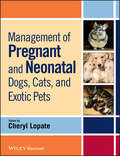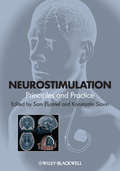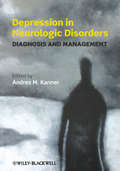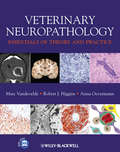- Table View
- List View
Management of Pregnant and Neonatal Dogs, Cats, and Exotic Pets
by Cheryl LopateManagement of Pregnant and Neonatal Dogs, Cats, and Exotic Pets is a comprehensive yet practical reference on small animal neonatology. Covering reproductive physiology of pregnancy and parturition, normal neonatology, and neonatal disorders in dogs, cats, and small exotic mammals, the book gives special emphasis to fetal well-being, parturition, normal physical parameters, behavior, common disorders and defects, emergency care, and orphan management. Information on nutritional and environmental considerations for both the dam and offspring is included, as well as guidance on offering advice to breeders providing neonatal care at home. Well illustrated throughout, Management of Pregnant and Neonatal Dogs, Cats, and Exotic Pets is a complete resource for the successful management of pregnant and newborn pets. Veterinary practitioners, students, technicians, and professional breeders all will find the book’s how-to, clinically relevant approach to small animal neonatology invaluable.
Clinical Data Interpretation for Medical Finals: Single Best Answer Questions
by Philip Pastides Parveen JayiaWritten by senior clinicians across a range of specialties, Data Interpretation for Medical Finals: Single Best Answer Questions is the perfect way to prepare for data interpretation assessments and clinical practice. Featuring over 200 questions on key topics in medicine, each question is set around an image or investigation, such as an X-ray, CT scan, or blood film, and tests identification and interpretation of the data provided. Thorough explanation of the correct and incorrect answers helps you learn from mistakes. The questions reflect current exam question style and incorporate high quality images, many of which are annotated, and are presented in full colour throughout. Data Interpretation for Medical Finals will help build the confidence of all medical students, and Foundation Doctors, as it encourages application of investigation results to clinical decision making.
Clinical Data Interpretation for Medical Finals: Single Best Answer Questions
by Philip Socrates Pastides Parveen JayiaWritten by senior clinicians across a range of specialties, Data Interpretation for Medical Finals: Single Best Answer Questions is the perfect way to prepare for data interpretation assessments and clinical practice. Featuring over 200 questions on key topics in medicine, each question is set around an image or investigation, such as an X-ray, CT scan, or blood film, and tests identification and interpretation of the data provided. Thorough explanation of the correct and incorrect answers helps you learn from mistakes. The questions reflect current exam question style and incorporate high quality images, many of which are annotated, and are presented in full colour throughout. Data Interpretation for Medical Finals will help build the confidence of all medical students, and Foundation Doctors, as it encourages application of investigation results to clinical decision making.
Practical Hemostasis and Thrombosis
by Nigel S. Key Michael Makris David LillicrapDesigned as a practical, succinct guide, for quick reference by clinicians with everyday questions, this title guides the reader through the range of approaches available for diagnosis, management, or prevention of hemorrhagic and thrombotic diseases or disorders. Provides essential practical management for all those working in the field of hemostasis and thrombosis Includes new chapters on direct oral anticoagulants, acquired inhibitors of coagulation, and expanded discussion of thrombotic microangiopathies Covers in a clear and succinct format, the diagnosis, treatment and prevention of thrombotic and haemostatic disorders Follows templated chapter formats for rapid referral, including key points and summary boxes, and further reading Highlights controversial issues and provides advice for everyday questions encountered in the clinic
Practical Hemostasis and Thrombosis
by Nigel Key Michael Makris David LillicrapDesigned as a practical, succinct guide, for quick reference by clinicians with everyday questions, this title guides the reader through the range of approaches available for diagnosis, management, or prevention of hemorrhagic and thrombotic diseases or disorders. Provides essential practical management for all those working in the field of hemostasis and thrombosis Includes new chapters on direct oral anticoagulants, acquired inhibitors of coagulation, and expanded discussion of thrombotic microangiopathies Covers in a clear and succinct format, the diagnosis, treatment and prevention of thrombotic and haemostatic disorders Follows templated chapter formats for rapid referral, including key points and summary boxes, and further reading Highlights controversial issues and provides advice for everyday questions encountered in the clinic
Obstetrics and Gynecology at a Glance (At a Glance)
by Errol R. Norwitz John O. SchorgeThis comprehensively updated new edition provides a thorough and dynamically-illustrated overview of the female reproductive organs, care of the female during pregnancy, childbirth and the postnatal period. It is clinically relevant, with a focus on diagnosing, managing and treating disorders and abnormalities and is fully aligned with medical school curricula. Obstetrics and Gynecology at a Glance: • Recaps basic history taking, anatomy and endocrinology and focuses on clinically relevant information • Covers each topic in a double-page spread, packed with charts, graphs, photographs and visuals • Includes thoroughly updated sections on reproductive endocrinology, infertility and urogynecology The companion website at www.ataglanceseries.com/obgyn features interactive flashcards, case studies and multiple-choice questions (MCQs). Obstetrics and Gynecology at a Glance is the perfect guide for medical students, junior doctors and midwives, and is ideal for those embarking on clinical rotations and the clerkship.
Obstetrics and Gynecology at a Glance (At a Glance)
by Errol R. Norwitz John O. SchorgeThis comprehensively updated new edition provides a thorough and dynamically-illustrated overview of the female reproductive organs, care of the female during pregnancy, childbirth and the postnatal period. It is clinically relevant, with a focus on diagnosing, managing and treating disorders and abnormalities and is fully aligned with medical school curricula. Obstetrics and Gynecology at a Glance: • Recaps basic history taking, anatomy and endocrinology and focuses on clinically relevant information • Covers each topic in a double-page spread, packed with charts, graphs, photographs and visuals • Includes thoroughly updated sections on reproductive endocrinology, infertility and urogynecology The companion website at www.ataglanceseries.com/obgyn features interactive flashcards, case studies and multiple-choice questions (MCQs). Obstetrics and Gynecology at a Glance is the perfect guide for medical students, junior doctors and midwives, and is ideal for those embarking on clinical rotations and the clerkship.
Textbook of Pharmacoepidemiology
by Brian L. Strom Stephen E. Kimmel Sean HennessyTextbook of Pharmacoepidemiology, Second Edition, provides an introduction to pharmacoepidemiology and the data sources, methods and applications used in clinical research, the pharmaceutical industryand regulatory agencies. Drawing upon the fifth edition of the authoritative reference, Pharmacoepidemiology, this new edition covers the key learning requirements of the discipline. The textbook provides an introduction topharmacoepidemiology, pharmacoepidemiological data sources, special issues in methodology, special applications and future developments in the field. Updated learning features such as case studies, key points and Suggested Further Reading are included throughout the text. Textbook of Pharmacoepidemiology is a practical educational resource for upper-level undergraduates, graduate students, post-doctoral fellows in schools of public health, pharmacy and medicine, and for everyone learning and working in pharmacoepidemiology.
Textbook of Pharmacoepidemiology
by Brian L. Strom Stephen E. Kimmel Sean HennessyTextbook of Pharmacoepidemiology, Second Edition, provides an introduction to pharmacoepidemiology and the data sources, methods and applications used in clinical research, the pharmaceutical industryand regulatory agencies. Drawing upon the fifth edition of the authoritative reference, Pharmacoepidemiology, this new edition covers the key learning requirements of the discipline. The textbook provides an introduction topharmacoepidemiology, pharmacoepidemiological data sources, special issues in methodology, special applications and future developments in the field. Updated learning features such as case studies, key points and Suggested Further Reading are included throughout the text. Textbook of Pharmacoepidemiology is a practical educational resource for upper-level undergraduates, graduate students, post-doctoral fellows in schools of public health, pharmacy and medicine, and for everyone learning and working in pharmacoepidemiology.
Clinical Pharmacology and Therapeutics (Lecture Notes)
by Gerard A. McKay Matthew R. WaltersClinical Pharmacology and Therapeutics Lecture Notes provides a clear and accessible overview of all the key prescribing topics needed for medical finals and beyond. Detailed coverage and discussion of pharmacology in a clinical context, combined with an easy-to-understand, readable style, helps improve and test understanding of pharmacological principles and reasoning on rotation and into the foundation years. Key features for this edition include: • Clinical scenarios to root each chapter firmly in a real-life setting • Prescribing points flagging up important issues of clinical relevance • Expanded sections on drugs you may need in a hurry, prescribing and its pitfalls, and paediatric prescribing • A self-assessment section to test your knowledge and help prepare for examinations Clinical Pharmacology and Therapeutics Lecture Notes is an ideal resource for all medical students, junior doctors, and other prescribers, whether learning how pharmacological principles relate to clinical situations, brushing up on the basics while on rotation, or looking for a comprehensive overview of prescribing and therapeutics.
Clinical Pharmacology and Therapeutics (Lecture Notes #64)
by Gerard A. McKay Matthew R. WaltersClinical Pharmacology and Therapeutics Lecture Notes provides a clear and accessible overview of all the key prescribing topics needed for medical finals and beyond. Detailed coverage and discussion of pharmacology in a clinical context, combined with an easy-to-understand, readable style, helps improve and test understanding of pharmacological principles and reasoning on rotation and into the foundation years. Key features for this edition include: • Clinical scenarios to root each chapter firmly in a real-life setting • Prescribing points flagging up important issues of clinical relevance • Expanded sections on drugs you may need in a hurry, prescribing and its pitfalls, and paediatric prescribing • A self-assessment section to test your knowledge and help prepare for examinations Clinical Pharmacology and Therapeutics Lecture Notes is an ideal resource for all medical students, junior doctors, and other prescribers, whether learning how pharmacological principles relate to clinical situations, brushing up on the basics while on rotation, or looking for a comprehensive overview of prescribing and therapeutics.
Vaccinology: Principles and Practice
by W. John W. Morrow Nadeem A. Sheikh Clint S. Schmidt D. Huw DaviesCovering all aspects of vaccine research and development in one volume, this authoritative resource takes a comprehensive and systematic approach to the science of vaccinology focusing not only on basic science, but also on the many stages required to commercialize and navigate the regulatory requirements for human application, both in the United States and Europe. Reviews in detail the process of designing a vaccine, from the initial stages of antigen discovery to human application Includes evaluation of vaccine efficacy and safety Details clinical trial design, including regulatory requirements Discusses the emerging field of active cellular immunotherapy Vaccinology: Principles and Practice provides an invaluable resource for clinicians, scientific and medical researchers, lecturers and postdoctoral fellows working in the field of vaccines.
Vaccinology: Principles and Practice
by W. John W. Morrow Nadeem A. Sheikh Clint S. Schmidt D. Huw DaviesCovering all aspects of vaccine research and development in one volume, this authoritative resource takes a comprehensive and systematic approach to the science of vaccinology focusing not only on basic science, but also on the many stages required to commercialize and navigate the regulatory requirements for human application, both in the United States and Europe. Reviews in detail the process of designing a vaccine, from the initial stages of antigen discovery to human application Includes evaluation of vaccine efficacy and safety Details clinical trial design, including regulatory requirements Discusses the emerging field of active cellular immunotherapy Vaccinology: Principles and Practice provides an invaluable resource for clinicians, scientific and medical researchers, lecturers and postdoctoral fellows working in the field of vaccines.
Dietary Treatment of Epilepsy: Practical Implementation of Ketogenic Therapy
by Elizabeth NealEpilepsy is a common chronic neurological disorder characterised by recurrent unprovoked seizures, and affects 50 million people worldwide. Approximately 30% of these do not have seizure control even with the best available medications, hence renewed and increasing interest in the use of dietary treatments to treat epilepsy. These treatments include the traditional ketogenic diets but also the newer modified Atkins diet and low glycaemic index treatment. The ketogenic diet is a high-fat, adequate-protein, low-carbohydrate diet that in medicine is used primarily to treat refractory epilepsy in children, and requires the dedicated support of a multi-disciplinary team including doctors and dietitians. Dietary Treatment of Epilepsy: Practical Implementation of Ketogenic Therapy provides comprehensive and practical training on all aspects of implementing and managing dietary treatments for epilepsy, with key chapters on assessment, calculations, implementation, monitoring and complications. Edited by a highly respected expert in the field supported by a strong team of contributors, this is a must-have resource for paediatric dietitians and other members of the therapy team.
Dietary Treatment of Epilepsy: Practical Implementation of Ketogenic Therapy
by Elizabeth NealEpilepsy is a common chronic neurological disorder characterised by recurrent unprovoked seizures, and affects 50 million people worldwide. Approximately 30% of these do not have seizure control even with the best available medications, hence renewed and increasing interest in the use of dietary treatments to treat epilepsy. These treatments include the traditional ketogenic diets but also the newer modified Atkins diet and low glycaemic index treatment. The ketogenic diet is a high-fat, adequate-protein, low-carbohydrate diet that in medicine is used primarily to treat refractory epilepsy in children, and requires the dedicated support of a multi-disciplinary team including doctors and dietitians. Dietary Treatment of Epilepsy: Practical Implementation of Ketogenic Therapy provides comprehensive and practical training on all aspects of implementing and managing dietary treatments for epilepsy, with key chapters on assessment, calculations, implementation, monitoring and complications. Edited by a highly respected expert in the field supported by a strong team of contributors, this is a must-have resource for paediatric dietitians and other members of the therapy team.
Neurostimulation: Principles and Practice
by Sam Eljamel Konstantin V. SlavinCould neurostimulation be a management option for your patients? Neurostimulation techniques present real management options for patients with a range of neurologic and psychiatric disorders, such as movement disorders, pain, and depression. They should be actively considered when conventional medical approaches have failed or are inappropriate. But for many clinicians, these new methods pose many questions. What are the available modalities? How do they work? Which patients might benefit from them? How do I explain the processes to patients? How do I monitor my patient’s progress after implantation? Neurostimulation: Principles and Practice provides a concise, easy-to-read fusion of the clinical applications of implanted neurostimulators. It demystifies selection and referral criteria, maximizing therapy, programming the implanted neuromodulators, monitoring progress, and troubleshooting problems associated with neurostimulation. Neurostimulation: Principles and Practice covers the modalities available for your patients: Deep brain stimulation Motor cortex stimulation Vagus nerve stimulation Spinal cord stimulation Peripheral nerve stimulation Written by an international cast of experts, Neurostimulation: Principles and Practice sets the stage for you to provide real clinical benefit to your patients who might receive, or are already using, neurostimulators.
Neurostimulation: Principles and Practice
by Sam Eljamel Konstantin SlavinCould neurostimulation be a management option for your patients? Neurostimulation techniques present real management options for patients with a range of neurologic and psychiatric disorders, such as movement disorders, pain, and depression. They should be actively considered when conventional medical approaches have failed or are inappropriate. But for many clinicians, these new methods pose many questions. What are the available modalities? How do they work? Which patients might benefit from them? How do I explain the processes to patients? How do I monitor my patient’s progress after implantation? Neurostimulation: Principles and Practice provides a concise, easy-to-read fusion of the clinical applications of implanted neurostimulators. It demystifies selection and referral criteria, maximizing therapy, programming the implanted neuromodulators, monitoring progress, and troubleshooting problems associated with neurostimulation. Neurostimulation: Principles and Practice covers the modalities available for your patients: Deep brain stimulation Motor cortex stimulation Vagus nerve stimulation Spinal cord stimulation Peripheral nerve stimulation Written by an international cast of experts, Neurostimulation: Principles and Practice sets the stage for you to provide real clinical benefit to your patients who might receive, or are already using, neurostimulators.
Oral Precancer: Diagnosis and Management of Potentially Malignant Disorders
by Peter ThomsonWithout early detection, oral cancer is deadly. Protect your patients by applying the latest clinical interventions. Rates of new oral cancer cases continue to increase and mortality rates remain alarmingly high. Oralcancer may be preceded by clinically identifiable precancerous changes in the oral mucosa, which offer a therapeutic window of opportunity to intervene and halt disease progression to carcinoma development. Written and edited by prominent researchers in the field, Oral Precancer: Reviews current scientific research on precancer conditions of the oral cavity providing evidence-based analysis of the nature and behavior of potentially malignant and deforming oral diseases Explains the principles of prevention, diagnosis and management of potentially malignant disorders of the oral cavity Details a practical and reliable interventional treatment strategy to facilitate early diagnosis and effective treatment of both precancer and early invasive carcinoma Contains a chapter devoted to illustrative case histories, high-quality, color, clinical photos, reference sections in each chapter listing relevant review articles, and more From start to finish, Oral Precancer offers undergraduate students, clinicians, and professors an invaluable resource to minimise the morbidity and mortality of this most significant and life threatening of oral conditions.
Oral Precancer: Diagnosis and Management of Potentially Malignant Disorders
by Peter ThomsonWithout early detection, oral cancer is deadly. Protect your patients by applying the latest clinical interventions. Rates of new oral cancer cases continue to increase and mortality rates remain alarmingly high. Oralcancer may be preceded by clinically identifiable precancerous changes in the oral mucosa, which offer a therapeutic window of opportunity to intervene and halt disease progression to carcinoma development. Written and edited by prominent researchers in the field, Oral Precancer: Reviews current scientific research on precancer conditions of the oral cavity providing evidence-based analysis of the nature and behavior of potentially malignant and deforming oral diseases Explains the principles of prevention, diagnosis and management of potentially malignant disorders of the oral cavity Details a practical and reliable interventional treatment strategy to facilitate early diagnosis and effective treatment of both precancer and early invasive carcinoma Contains a chapter devoted to illustrative case histories, high-quality, color, clinical photos, reference sections in each chapter listing relevant review articles, and more From start to finish, Oral Precancer offers undergraduate students, clinicians, and professors an invaluable resource to minimise the morbidity and mortality of this most significant and life threatening of oral conditions.
Prostate Cancer: Diagnosis and Clinical Management
by Peter Whelan Ashutosh K. Tewari John D. GrahamDo you manage patients with prostate cancer? Could you use an expert guide examining all possible management options? Prostate Cancer: diagnosis and clinical management providesurologists and oncologists of all levels with up-to-date, evidence-based guidance to the diagnosis, treatment and clinical management of a disease which accounts for a quarter of all cancers affecting men. Designed to be as practical and accessible as possible, leading experts discuss key issues in prostate cancer management and examine how to deliver best practice in the clinical care of their patients. Topics covered include: What must be considered when counseling newly-diagnosed cancer patients Radical surgery options for prostate cancer Novel therapies for localized prostate cancer How should metastatic prostate cancer be diagnostic and managed What are the best methods of administering end of life care for the patient Brought to you by a highly experienced editor team, and containing key points, management algorithms, practice tips and the latest AUA and EAU clinical guidelines, this is the ideal consultation tool for doctors both on the wards and in the office.
Prostate Cancer: Diagnosis and Clinical Management
by Ashutosh K. Tewari Peter Whelan John GrahamDo you manage patients with prostate cancer? Could you use an expert guide examining all possible management options? Prostate Cancer: diagnosis and clinical management providesurologists and oncologists of all levels with up-to-date, evidence-based guidance to the diagnosis, treatment and clinical management of a disease which accounts for a quarter of all cancers affecting men. Designed to be as practical and accessible as possible, leading experts discuss key issues in prostate cancer management and examine how to deliver best practice in the clinical care of their patients. Topics covered include: What must be considered when counseling newly-diagnosed cancer patients Radical surgery options for prostate cancer Novel therapies for localized prostate cancer How should metastatic prostate cancer be diagnostic and managed What are the best methods of administering end of life care for the patient Brought to you by a highly experienced editor team, and containing key points, management algorithms, practice tips and the latest AUA and EAU clinical guidelines, this is the ideal consultation tool for doctors both on the wards and in the office.
Depression in Neurologic Disorders: Diagnosis and Management
by Andres KannerThe first part of the book begins with an overview of depression, its incidence and manifestations and neurobiological origins; how it's diagnosed; and its relevance to neurology, in particular to suicidality. The second part looks at depression in distinct conditions, in particular: migraine, stroke, epilepsy, Parkinson's Disease, Huntington's Disease, dementia, and traumatic brain injury. This useful guide takes a practical approach, with "tips and tricks" boxes, case studies, points of interest boxes, and take-home summaries.
Depression in Neurologic Disorders: Diagnosis and Management
by Andres M. KannerThe first part of the book begins with an overview of depression, its incidence and manifestations and neurobiological origins; how it's diagnosed; and its relevance to neurology, in particular to suicidality. The second part looks at depression in distinct conditions, in particular: migraine, stroke, epilepsy, Parkinson's Disease, Huntington's Disease, dementia, and traumatic brain injury. This useful guide takes a practical approach, with "tips and tricks" boxes, case studies, points of interest boxes, and take-home summaries.
Veterinary Neuropathology: Essentials of Theory and Practice
by Marc Vandevelde Robert Higgins Anna OevermannIntroducing the theoretical and practical basics of veterinary neuropathology, this concise and well illustrated book is an essential basic diagnostic guide for pathologists, neurologists and diagnostic imaging specialists. It presents readers with strategies to deal with neuropathological problems, showing how to interpret gross and histological lesions using a systematic approach based on pattern recognition. It starts with an overview of the general principles of neuroanatomy, neuropathological techniques, basic tissue reaction patterns, and recognition of major lesion patterns. The book goes on to cover vascular diseases, inflammatory diseases, trauma, congenital malformations, metabolic-toxic diseases, neoplasia and degenerative diseases mainly of the central nervous system. In the respective chapters pathologists can quickly find information to support their daily diagnostic workup for both small and large domestic species. Based on the authors’ extensive diagnostic and post graduate teaching experience as well as the inclusion of MRI as it relates to neuropathology, this book also offers a comprehensive but basic analysis of veterinary neuropathology that neurologists and other MRI users will find very useful. • An essential manual for daily diagnostic work • Richly illustrated with high quality colour gross, histological and MRI images • Includes a section on the function and use of MRI (by Johann Lang, DECVDI) • Accompanied by a website presenting MRI sequences for interpretation and correlation with neuropathological findings edited by Johann Lang (University of Bern, Switzerland) and Eric Wiesner (University of California, Davis, USA)
Multicultural Handbook of Food, Nutrition and Dietetics
by Aruna Thaker Arlene BartonMulticultural Handbook of Food, Nutrition and Dietetics is the must have practical resource for dietitians, nutritionists and students working with both well settled but also recently migrated ethnic groups.Written by a team of authors drawn from the British Dietetic Association's Specialist Multicultural Nutrition Group the book provides in-depth information to equip the reader in the provision of nutrition advice to minority groups. Spanning a broad range of cultural groups the book seeks to consider religious and cultural requirements in relation to traditional diets; research on migration studies and chronic disease states; and nutrition and dietetic treatment in relation to key chronic diseases.













